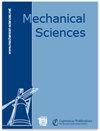机械臂有效载荷自适应迭代学习控制
IF 1.5
4区 工程技术
Q4 ENGINEERING, MECHANICAL
引用次数: 2
摘要
摘要迭代学习控制(ILC)方法的主要目的是减少由于机器人动力学模型不准确而导致的轨迹跟踪误差。它估计跟踪误差,并对输出控制信号应用学习算子进行校正。今天的ILC研究人员提出了提高ILC整体性能和最小化所需迭代次数的策略。当一个有效载荷(或不同的末端执行器)附加到机器人机械手上时,机器人的动力学会发生变化。当增加一个新的有效载荷时,即使是最精确的动力学近似模型也会被改变。这将需要改变动力学估计,如果使用ilc过程来控制系统,则可以避免这种情况。当考虑机械臂时,本文分析了载荷对动力学的影响,并提出了改进ILC过程的方法。这项研究着眼于scara型机器人的动力学。它的惯性矩阵由附着在它上面的有效载荷决定。结果表明,ILC方法可以修正载荷变化引起的惯性矩阵估计误差,但需要更多的迭代。在没有负载属性的任何额外数据的情况下,建议的技术可以调整和微调学习操作符。在预设的参考弹道上,对载荷适应过程进行了实证检验。当装载相同的载荷时,所获得的自适应改进将被用于另一个期望的弹道。通过计算机仿真验证了所提方法的有效性。该方法提高了具有一组相似轨迹但不同类型末端执行器或有效载荷的工业机器人的ILC的整体性能。本文章由计算机程序翻译,如有差异,请以英文原文为准。
Payload-adaptive iterative learning control for robotic manipulators
Abstract. The main purpose of the iterative learning control (ILC) method is to reduce the trajectory tracking error caused by an inaccurate model of the
robot's dynamics. It estimates the tracking error and applies a learning operator to the output control signals to correct them. Today's ILC
researchers are suggesting strategies for increasing the ILC's overall performance and minimizing the number of iterations required. When a payload
(or a different end effector) is attached to a robotic manipulator, the dynamics of the robot change. When a new payload is added, even the most
accurately approximated model of the dynamics will be altered. This will necessitate changes to the dynamics estimates, which may be avoided if the ILC
process is used to control the system. When robotic manipulators are considered, this study analyses how the payload affects the dynamics and
proposes ways to improve the ILC process. The study looks at the dynamics of a SCARA-type robot. Its inertia matrix is determined by the payload
attached to it. The results show that the ILC method can correct for the estimated inertia matrix inaccuracy caused by the changing payload but at
the cost of more iterations. Without any additional data of the payload's properties, the suggested technique may adjust and fine-tune the learning
operator. On a preset reference trajectory, the payload adaptation process is empirically tested. When the same payload is mounted, the acquired
adaptation improvements are then utilized for another desired trajectory. A computer simulation is also used to validate the suggested method. The
suggested method increases the overall performance of ILC for industrial robotic manipulators with a set of similar trajectories but different types
of end effectors or payloads.
求助全文
通过发布文献求助,成功后即可免费获取论文全文。
去求助
来源期刊

Mechanical Sciences
ENGINEERING, MECHANICAL-
CiteScore
2.20
自引率
7.10%
发文量
74
审稿时长
29 weeks
期刊介绍:
The journal Mechanical Sciences (MS) is an international forum for the dissemination of original contributions in the field of theoretical and applied mechanics. Its main ambition is to provide a platform for young researchers to build up a portfolio of high-quality peer-reviewed journal articles. To this end we employ an open-access publication model with moderate page charges, aiming for fast publication and great citation opportunities. A large board of reputable editors makes this possible. The journal will also publish special issues dealing with the current state of the art and future research directions in mechanical sciences. While in-depth research articles are preferred, review articles and short communications will also be considered. We intend and believe to provide a means of publication which complements established journals in the field.
 求助内容:
求助内容: 应助结果提醒方式:
应助结果提醒方式:


